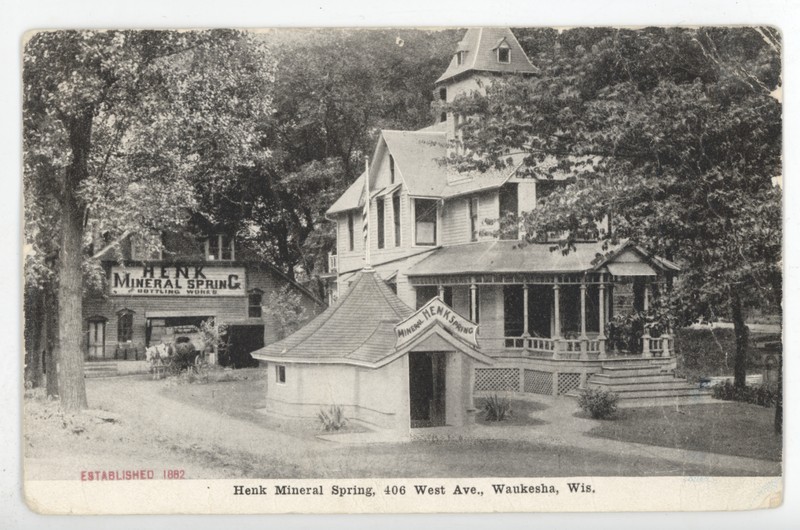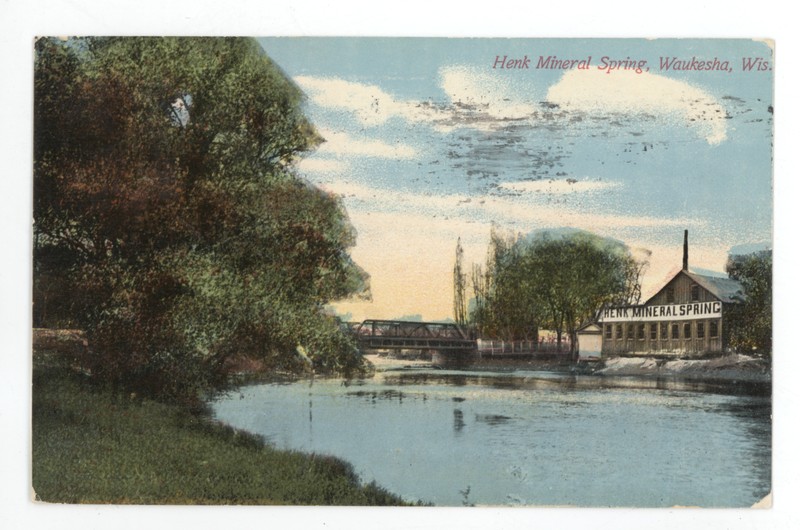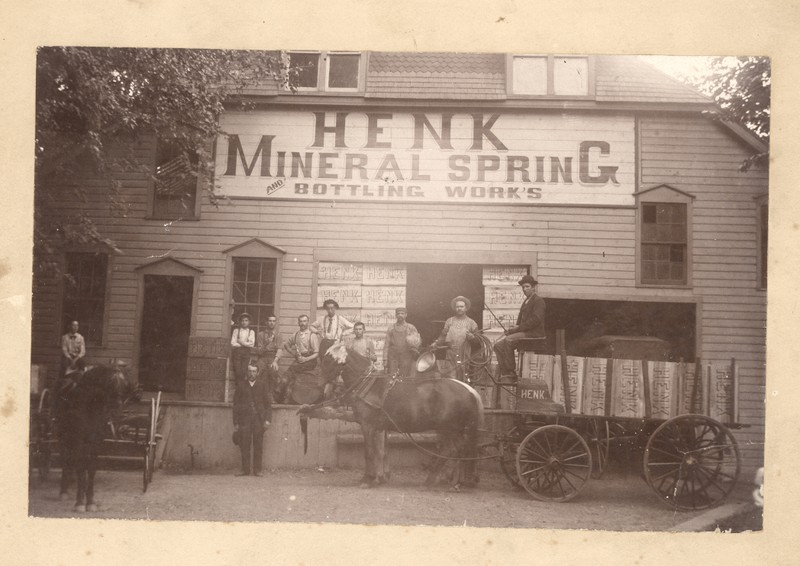Henk Mineral Spring
Introduction
Text-to-speech Audio
August Clemons Henk opened a mineral spring site here in 1881, part of the first wave of new spring businesses capitalizing on the growing industry of Waukesha. The site included a bottling plant, in addition to a spring house for visitors to 'take the water' directly from the spring. Bottled products included the bottled spring water, as well as other soda and mixer beverages. After August Henk's death in 1909, Henk Mineral Spring was passed onto his children. Attempts to expand and reorganize the Henk Mineral Spring, including a name change to Crystal Crown Mineral Spring Co., eventually failed and by 1922 the company went bankrupt. In 1924, the land and business were sold to A. A. Andrews who tore down the spring house and developed the land for other purposes.
Images
Postcard showing octagonal Henk springhouse

Henk Bottling plant as seen from across the Fox River

Photo showing the front of the bottling plant. Henk himself stands to the left next to the horse

Backstory and Context
Text-to-speech Audio
On December 13th, 1881, August Clemons and Maggie K. (Dambruch) Henk purchased property at 406 West Ave. in Waukesha. Prior to the purchase, August and his brother-in-law George Dambruch had a root beer bottling business in Milwaukee. George and Carrie (nee Henk) Dambruch, moved to Appleton and bottled root beer and eventually soda as the Appleton Bottling Works. Around the same time, August and Maggie moved to Waukesha, purchased the West Ave. property and immediately began improving and developing the natural spring into the Henk Mineral Spring.
This spring, like the rest of the springs in Waukesha, was a cold spring, used by many as a source of drinking water. The Waukesha Freeman newspaper reported on June 15th, 1882, that the bottling of spring water and beverages such as root beer and ginger ale had begun at the site. The bottling plant was located at the back of the property, along the bank of the Fox River. A springhouse was built to protect the spring from outside contaminants such as leaves, dirt, and rain. The springhouse was an octagonal structure with a doorway protruding from it. This would later be changed to a simple A-frame structure.
The 1890s proved to be a prosperous time for Henk Mineral Spring. In 1899 Henk was quoted saying that the company was putting out two train carloads of cases of products per week. The company bottled beverages and spring water year-round. They took advantage of the decrease in orders in winter to fill up reserves to ensure that they didn't run out during the summer when there was higher demand. At that time Henk Mineral Spring had 10 to 15 employees working for it.
One of the Henk Mineral Spring’s employees, John Wheeler, was seriously injured in an explosion of a large generator in July of 1890. John Wheeler recovered from his injuries and went on to bottle his own soda. August’s sons William, Edward, Arthur, and Clarence were also employed at the bottling plant at some point. When August Henk passed away on August 15th, 1909, ownership of the company and property, including debts, went to his family.
In 1918, August’s children involved with Henk Mineral Spring proposed changes to the company in an attempt to expand their reach and capitalize on the market in Milwaukee. To supply the Milwaukee markets, trucks would be run between Waukesha and Milwaukee. This idea never really got off the ground, and in 1919 the remaining members of the Henk family left the company.
The company reorganized in 1920 and was placed in the hands of Milwaukee attorney Carl H. Jurgens. The new company was called the Crystal Crown Mineral Spring Co. This name lasted only a year, and in 1921 the name was changed back to Waukesha Henk Company, Incorporated. The company went bankrupt on December 22, 1922. In June of 1924, the spring and land were sold to a man named A.A. Andrews. The spring house and buildings were demolished, and the land was developed for residential use.
Sources
Armour, Keith. Beglinger, Clarie. Hoefer, Beth. Nelson, Larry. Schoenknecht, John. Eds. Spring City Past. Edition 3. Waukesha, WI. City of Waukesha Landmarks Commission, 2001-2.
Schoenknecht, John M. A Blob Bottle Clue. Landmark Magazine. Summer-Autumn 1992, 60-62.
Schoenknecht, John Martin. Great Waukesha Springs Era 1868-1918. Edition 1. Waukesha, WI. John M. Schoenknecht, 2003.
Schoenknecht, John M. Waukesha's Henk Mineral Spring - A Story Inspired by a Bottle. Landmark Magazine. Summer 1991, 1-4, 31.
Waukesha Freeman, June 15th, 1881
Waukesha County Historical Society & Museum Photography collections
